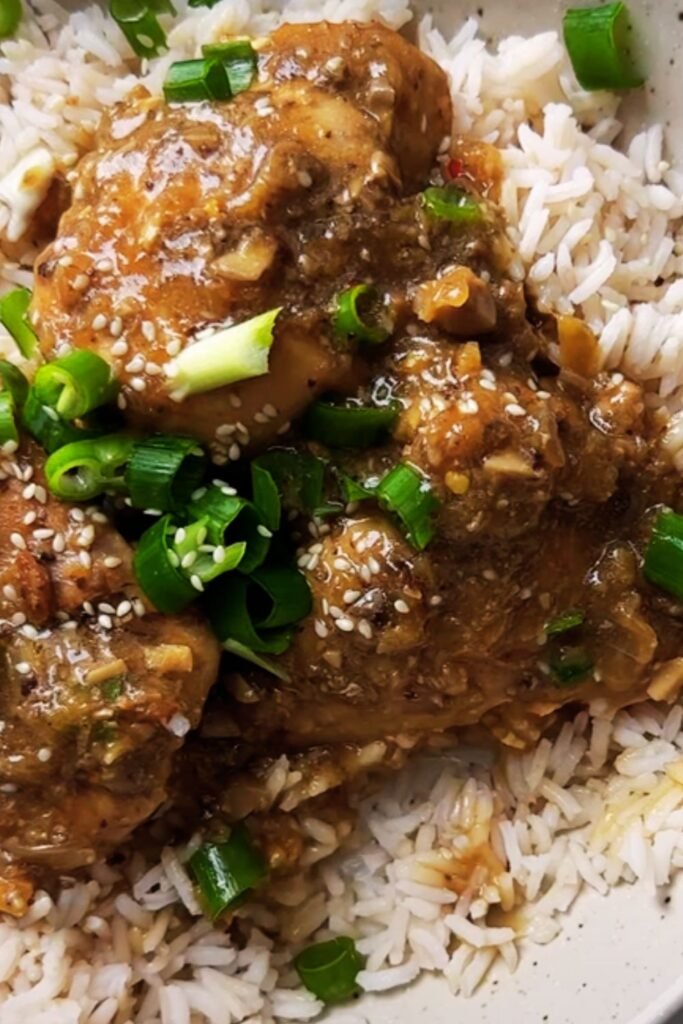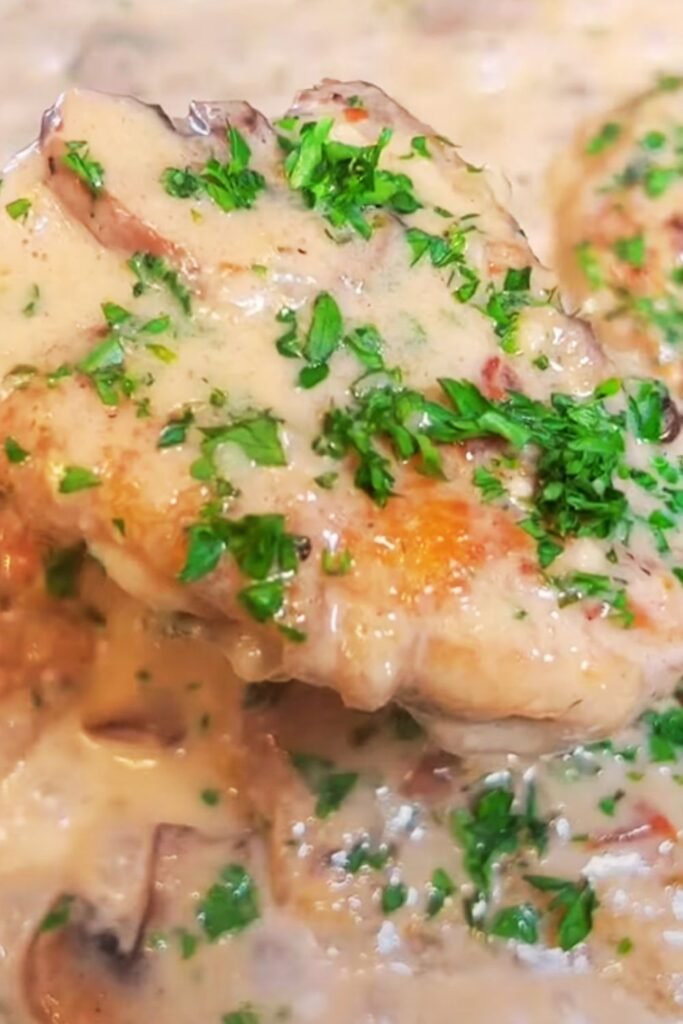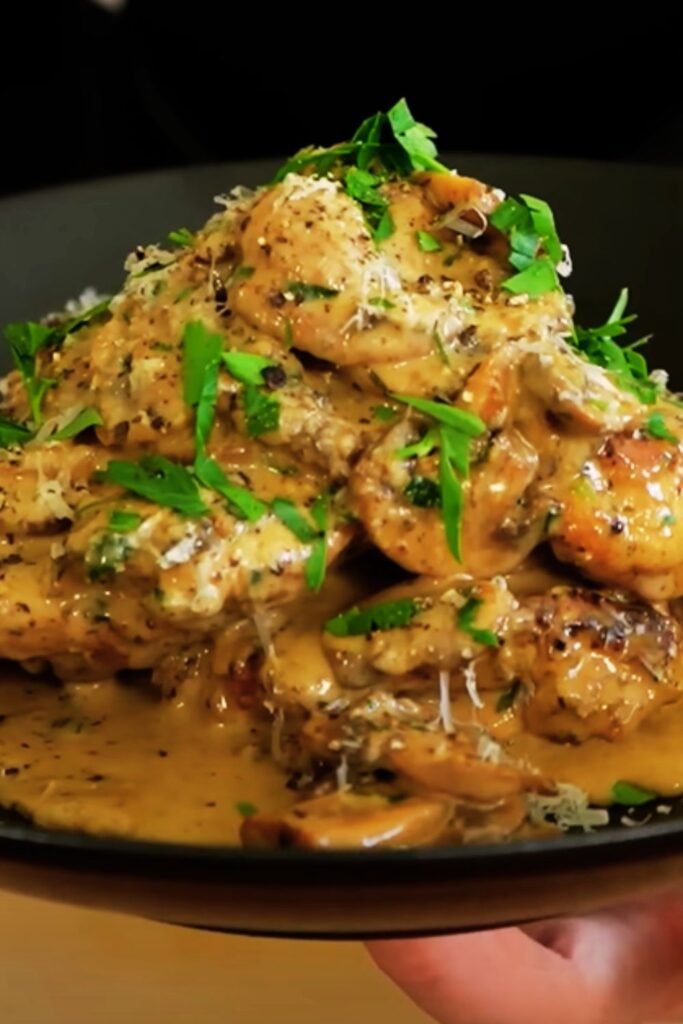When autumn arrives and the air turns crisp, I find myself craving dishes that embody the season’s warmth and richness. This chicken in butternut squash mushroom cream sauce has become my go-to recipe for those cozy evenings when I want something that feels both elegant and comforting. The combination of tender chicken, sweet butternut squash, earthy mushrooms, and velvety cream creates a harmony of flavors that never fails to impress both family and guests.
I’ve spent years perfecting this recipe, tweaking proportions and techniques until I achieved what I believe is the perfect balance. The natural sweetness of butternut squash pairs beautifully with the umami-rich mushrooms, while the cream ties everything together in a luxurious sauce that clings to each piece of chicken. What makes this dish particularly special is how it transforms simple ingredients into something truly spectacular.
Understanding the Key Components
Butternut Squash: This winter squash brings natural sweetness and a creamy texture when cooked. I prefer cubing it into 1-inch pieces for this recipe, as they hold their shape while becoming tender enough to complement the chicken.
Mushroom Selection: I typically use a combination of cremini and shiitake mushrooms. The cremini provide a meaty texture, while shiitakes add a deeper, more complex flavor profile that elevates the entire dish.
Chicken Choice: Boneless, skinless chicken thighs work best here. They remain moist during cooking and absorb the sauce flavors beautifully. However, chicken breasts can be substituted if preferred.
Cream Base: Heavy cream creates the luxurious sauce, but I’ve found that adding a splash of white wine or chicken broth helps prevent the cream from becoming too heavy.
Essential Ingredients and Measurements
| Ingredient | Quantity | Purpose | Notes |
|---|---|---|---|
| Chicken thighs (boneless, skinless) | 2 lbs | Main protein | Can substitute with breasts |
| Butternut squash | 3 cups, cubed | Sweetness and substance | Peel and cube into 1-inch pieces |
| Mixed mushrooms | 8 oz | Umami depth | Cremini and shiitake recommended |
| Heavy cream | 1 cup | Sauce base | Room temperature preferred |
| Chicken broth | 1/2 cup | Flavor enhancement | Low-sodium preferred |
| Yellow onion | 1 medium | Aromatic foundation | Diced finely |
| Garlic cloves | 4 large | Flavor base | Minced fresh |
| Fresh thyme | 2 tablespoons | Herb seasoning | Can substitute with 1 tbsp dried |
| Fresh sage | 1 tablespoon | Autumn flavor | Chopped finely |
| Olive oil | 3 tablespoons | Cooking fat | Extra virgin preferred |
| Butter | 2 tablespoons | Richness | Unsalted |
| All-purpose flour | 2 tablespoons | Thickening agent | For dusting chicken |
| Salt | To taste | Seasoning | Kosher salt preferred |
| Black pepper | To taste | Seasoning | Freshly ground |
| Paprika | 1 teaspoon | Color and mild flavor | Sweet paprika |
Step-by-Step Cooking Process
Preparation Phase
I always start by preparing all my ingredients before I begin cooking. This mise en place approach ensures smooth cooking without scrambling for ingredients mid-process.
• Chicken Preparation: Pat the chicken thighs dry with paper towels and season generously with salt, pepper, and paprika. Let them sit at room temperature for 15-20 minutes.
• Squash Preparation: Peel the butternut squash using a sharp vegetable peeler, then cut it in half lengthwise. Remove seeds and cube the flesh into uniform 1-inch pieces.
• Mushroom Preparation: Clean mushrooms with a damp paper towel (avoid washing them as they absorb water) and slice them into 1/4-inch thick pieces.
• Aromatics: Dice the onion finely and mince the garlic. Having these ready prevents burning during the cooking process.

Cooking the Chicken
I heat 2 tablespoons of olive oil in a large, heavy-bottomed skillet or Dutch oven over medium-high heat. The key here is achieving a beautiful golden-brown sear on the chicken.
Lightly dust the seasoned chicken thighs with flour, shaking off excess. This light coating helps create a beautiful crust and aids in thickening the sauce later. I place the chicken in the hot oil, being careful not to overcrowd the pan. Each piece should have space around it for proper browning.
The chicken needs about 4-5 minutes per side to develop that gorgeous golden color. I resist the urge to move them too early – patience here rewards you with superior flavor and texture. Once both sides are beautifully browned, I remove the chicken to a plate and tent with foil to keep warm.
Building the Sauce Foundation
In the same pan with those beautiful brown bits (the fond), I add the remaining tablespoon of olive oil and the butter. The combination creates an ideal cooking fat that won’t burn at higher temperatures while adding richness.
I add the diced onion to the pan and cook for 3-4 minutes until it becomes translucent and fragrant. The residual heat and fat help develop the onion’s sweetness, which forms the flavor foundation of our sauce.
Next goes the minced garlic, which I cook for just 30 seconds – any longer and it risks burning and becoming bitter. The aroma at this point is absolutely intoxicating and signals that we’re building something special.
Adding the Vegetables
The mushrooms go in next. I spread them in a single layer and let them cook undisturbed for 2-3 minutes. This allows them to release their moisture and begin browning. I then stir and continue cooking for another 2-3 minutes until they’re golden and have reduced in size.
Now comes the butternut squash. I add the cubed squash to the pan along with the fresh thyme and sage. The herbs release their essential oils when they hit the warm fat, infusing the entire dish with autumn flavors.
I season this mixture with salt and pepper, then add the chicken broth. This liquid helps steam the squash and prevents anything from sticking to the pan bottom. I bring this to a simmer, then reduce heat to medium-low and cover the pan.

Sauce Development and Final Assembly
After about 10-12 minutes, the butternut squash should be fork-tender. This is when I return the chicken to the pan, nestling the pieces among the vegetables. The chicken needs to finish cooking through while the flavors meld together.
I pour the heavy cream over everything, being careful not to pour it directly onto the hot chicken as this can cause the cream to curdle. Instead, I pour it around the edges of the pan, then gently stir to combine.
The sauce will initially seem thin, but as it simmers gently for 8-10 minutes, it will thicken beautifully. The starches from the butternut squash and the flour coating on the chicken help create this natural thickening. I taste and adjust seasoning as needed.
Nutritional Information and Benefits
| Nutrient | Per Serving (6 servings) | Daily Value % |
|---|---|---|
| Calories | 485 | 24% |
| Protein | 32g | 64% |
| Carbohydrates | 18g | 6% |
| Dietary Fiber | 3g | 12% |
| Total Fat | 32g | 41% |
| Saturated Fat | 15g | 75% |
| Cholesterol | 145mg | 48% |
| Sodium | 680mg | 30% |
| Vitamin A | 1250 IU | 25% |
| Vitamin C | 28mg | 31% |
| Calcium | 120mg | 12% |
| Iron | 2.5mg | 14% |
This dish provides excellent nutritional value, particularly in vitamin A from the butternut squash and high-quality protein from the chicken. The mushrooms contribute beneficial minerals and compounds that support immune function.
Serving Suggestions and Pairings
I’ve found this dish pairs beautifully with various sides that complement rather than compete with the rich cream sauce:
• Grain Options: Wild rice pilaf, quinoa, or creamy polenta provide excellent bases that absorb the luscious sauce
• Vegetable Sides: Roasted Brussels sprouts, steamed green beans, or sautéed spinach add color and nutritional balance
• Bread Pairings: Crusty artisan bread, dinner rolls, or garlic bread help soak up every drop of the precious sauce
• Salad Complements: A simple arugula salad with lemon vinaigrette cuts through the richness beautifully
For special occasions, I like to garnish with toasted pumpkin seeds, fresh herbs, or a drizzle of good olive oil for visual appeal and added texture.
Storage and Reheating Guidelines
| Storage Method | Duration | Best Practices |
|---|---|---|
| Refrigerator | 3-4 days | Store in airtight container |
| Freezer | 2-3 months | Portion into freezer-safe containers |
| Reheating (stovetop) | 5-8 minutes | Add splash of broth if needed |
| Reheating (oven) | 20 minutes at 350°F | Cover with foil to prevent drying |
| Microwave | 2-3 minutes | Heat in 30-second intervals, stirring between |
I always recommend reheating gently to prevent the cream sauce from separating. If the sauce appears broken after reheating, a quick whisk usually brings it back together.

Common Variations and Substitutions
Over the years, I’ve experimented with numerous variations of this recipe to accommodate different dietary needs and preferences:
Dairy-Free Version: Coconut cream works surprisingly well as a substitute for heavy cream, adding a subtle tropical note that complements the squash beautifully.
Lower-Calorie Option: I’ve successfully used half-and-half instead of heavy cream, though the sauce won’t be quite as rich. Adding a tablespoon of cream cheese helps maintain body.
Protein Alternatives: Turkey tenderloin, pork tenderloin, or even firm white fish work wonderfully with this sauce combination.
Vegetable Additions: Diced carrots, parsnips, or sweet potatoes can supplement or replace some of the butternut squash for varied flavors and textures.
Herb Variations: Rosemary, oregano, or even a touch of cinnamon can create interesting flavor profiles depending on your preference.
Troubleshooting Common Issues
Cream Sauce Separating: This usually happens from overheating. Remove from heat immediately and whisk in a tablespoon of cold cream to bring it back together.
Bland Flavor: This often indicates under-seasoning. Don’t forget that cream-based sauces need generous seasoning to shine through the richness.
Mushy Butternut Squash: Cut pieces uniformly and don’t overcook. The squash should be tender but still hold its shape.
Dry Chicken: This happens from overcooking. Use a meat thermometer – chicken is done at 165°F internal temperature.
Thin Sauce: Allow more simmering time for natural reduction, or whisk in a slurry of cornstarch and cold water.
Seasonal Shopping and Ingredient Selection
I’ve learned that ingredient quality significantly impacts the final dish. For butternut squash, I look for specimens that feel heavy for their size with no soft spots. The stem should be dry and the skin should have a matte finish rather than glossy.
When selecting mushrooms, I choose ones that are firm and dry with no dark spots or slimy texture. I store them in paper bags rather than plastic to prevent moisture buildup.
For chicken, I prefer thighs from reputable sources, ideally organic or free-range for better flavor and texture. The meat should have a pinkish color with no off odors.
Advanced Techniques for Perfect Results
Proper Searing: The key to exceptional flavor lies in proper browning. I ensure the pan is hot enough that a drop of water sizzles immediately upon contact.
Temperature Control: I maintain gentle simmering rather than vigorous boiling to prevent cream separation and ensure even cooking.
Seasoning Layers: I season at multiple stages – the chicken before cooking, the vegetables while sautéing, and the final sauce before serving.
Resting Time: I let the finished dish rest for 5 minutes before serving, allowing flavors to settle and the sauce to reach optimal consistency.
Q&A Section
Q: Can I make this dish ahead of time for entertaining? I absolutely recommend making this dish ahead for parties. The flavors actually improve after sitting for a few hours. I prepare everything through the final simmering, then gently reheat when ready to serve. Just add a splash of broth if the sauce has thickened too much during storage.
Q: What’s the best way to cut butternut squash safely? I start by cutting off both ends to create stable surfaces. Then I peel the entire squash with a sharp vegetable peeler. Cut it in half where the neck meets the bulb, then tackle each section separately. The neck cuts easily into rounds, then cubes. For the bulb, scoop out seeds first, then cut into strips and cube.
Q: Can I use frozen butternut squash for this recipe? While fresh is preferred, frozen butternut squash works in a pinch. I thaw it completely and drain excess moisture first. The cooking time may be slightly shorter since frozen squash is partially cooked during the blanching process before freezing.
Q: Why does my cream sauce sometimes curdle? Cream curdles from temperature shock or acidity. I always bring cream to room temperature before adding it to hot ingredients. Also, avoid high heat once cream is added – gentle simmering is key. If it does curdle, remove from heat and whisk vigorously while adding cold cream a tablespoon at a time.
Q: Can I substitute different types of mushrooms? Absolutely! Button mushrooms work fine, though they’re milder. Portobello mushrooms add meatiness but should be chopped smaller. Oyster mushrooms provide a delicate flavor. I avoid very delicate mushrooms like enoki as they break down too much during cooking.
Q: How do I know when the chicken is properly cooked? I use a meat thermometer to ensure accuracy – chicken should reach 165°F internal temperature. Visually, the juices should run clear when pierced, and the meat should no longer be pink. However, temperature is the most reliable indicator.
Q: Is there a way to make this recipe in a slow cooker? I’ve adapted this for slow cookers with good results. Brown the chicken first, then layer all ingredients in the slow cooker. Cook on low for 4-5 hours. Add the cream during the last 30 minutes to prevent separation. The texture will be slightly different but equally delicious.
Q: What wine pairs best with this dish? A medium-bodied white like Chardonnay complements the creamy richness, while the butternut squash’s sweetness pairs beautifully with a light Pinot Noir. For non-alcoholic options, sparkling apple cider or a rich tea blend works wonderfully.
This recipe has become one of my most requested dishes, and I hope it brings the same warmth and satisfaction to your table that it has to mine. The combination of seasonal ingredients creates something truly special that captures the essence of autumn in every bite.